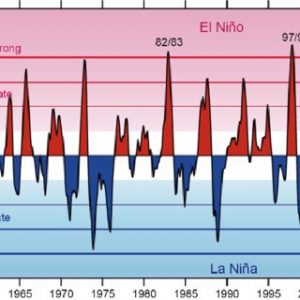ForumIAS announcing GS Foundation Program for UPSC CSE 2025-26 from 19 April. Click Here for more information.
Source-This post on Oceanic Niño Index has been created based on the article ” Two reasons why food inflation may soften in the months ahead” published in “The Indian Express” on 9 April 2024.
Why in the news?
The US National Oceanic and Atmospheric Administration (NOAA) has predicted that there is a 83% chance that the Oceanic Niño Index (ONI) will move into a neutral range by April-June 2024. It is predicted that El Nino event will not take place due to ONI moving into neutral range.
About Oceanic Niño Index (ONI)

1) ENSO is measured by two indices- Oceanic Niño Index and Southern Oscillation Index- Oceanic Nino Index (ONI) is the primary indicator for monitoring the ocean part of El Niño-Southern Oscillation, or “ENSO”. Southern Oscillation Index (SOI) is the primary indicator for monitoring the atmospheric part of ENSO.
2) The ONI tracks the running 3-month average sea surface temperatures in the east-central tropical Pacific between 120°-170°W, near the International Dateline. It also determines whether they are warmer or cooler than average.
3) ONI values are used to predict El Niño and La Niña-
| ONI Value | Meaning | Event Predicted |
| +0.5 or higher | Surface waters in the east-central tropical Pacific are 0.5 degrees Celsius or more warmer than average. | El Niño |
| -0.5 or lower | Surface waters in the east-central tropical Pacific are 0.5 degrees Celsius or less cooler than average. | La Niña |
What are El Nino and La Nina?
Description-El Nino and La Nina are two opposing climate trends that deviate from the normal conditions and normally run 9 to 12 months. El Nino is known as the warm phase and La Nina is known as the cold phase of ENSO.
Frequency– These events occur every 2 to 7 years on average. El Niño is more frequent than La Nina. They are together referred to as the El Niño-Southern Oscillation (ENSO) cycle by scientists.
Impacts– Both El Nino and La Nina have global effects on weather, wildfires, ecosystems and economics.
Read more- El Nino: Concept and impacts
UPSC Syllabus-Geography in news




